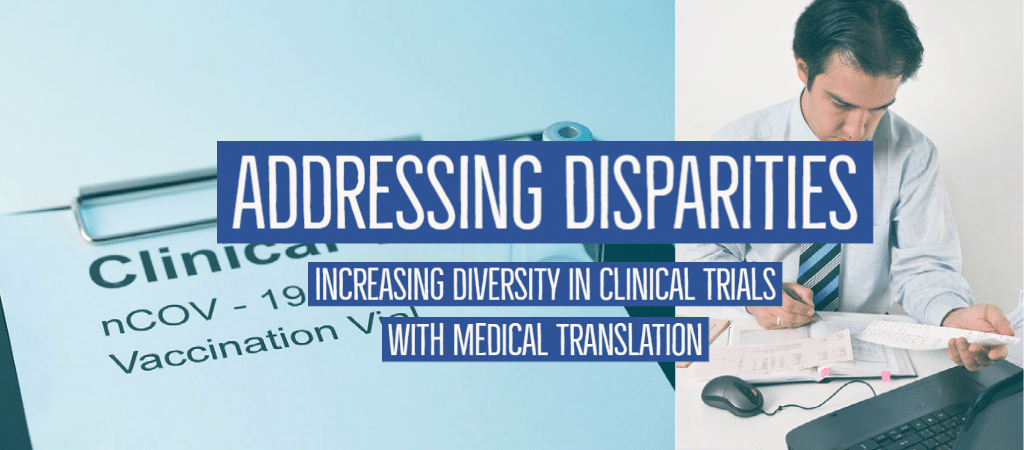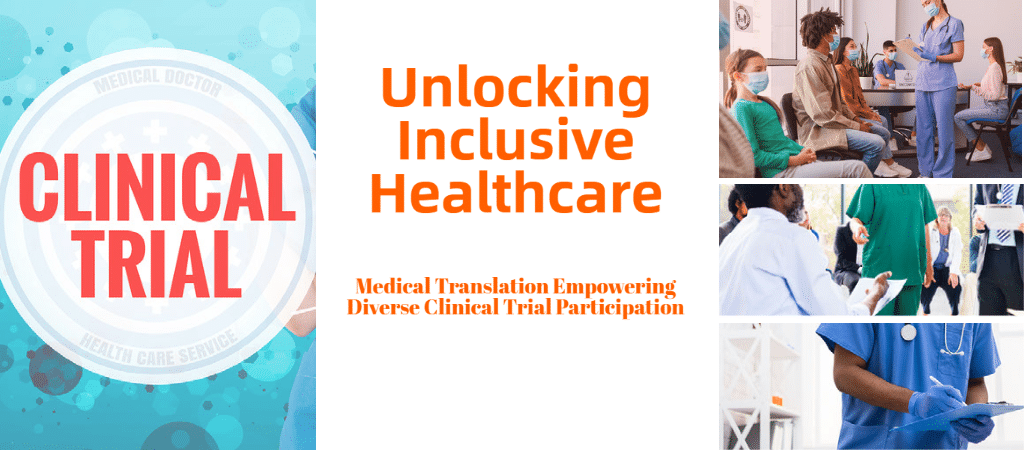
Introduction
Clinical trials are the cornerstone of developing new medications, therapies, and medical devices, aiming to improve healthcare outcomes for all. However, a significant issue affecting these trials is the underrepresentation of Black and Latino patients, leading to disparities in clinical trials. According to the FDA, between 2015 and 2019, only 14% of clinical trial participants were Black, and 18% were Hispanic, despite representing about 39% of the U.S. population. This article delves into how language barriers contribute to these disparities and highlights the critical role of medical translation in promoting diversity in clinical trials on a global scale.
Expanding on Underrepresented Groups in Clinical Trials In addition to Black and Latino patients, other underrepresented groups in clinical trials include indigenous populations, Asian communities, and individuals with disabilities. Language barriers can also impact their participation in clinical trials, further limiting the applicability of research findings to diverse groups.
The Global Impact of Language Barriers on Clinical Trial Participation
Language barriers pose a considerable challenge for non-English-speaking patients, particularly in Black and Latino communities. A study published in the Journal of Racial and Ethnic Health Disparities found that limited English proficiency (LEP) is associated with a lower likelihood of participating in clinical trials. This is a significant concern, as the U.S. Census Bureau estimates that 67.3 million people in the United States speak a language other than English at home, and 41% of them have limited English proficiency. By not addressing language barriers, clinical trials fail to include a substantial portion of the population, limiting the applicability of research findings to diverse groups.
To overcome this challenge, the use of interpreters during the recruitment process can help engage non-English-speaking patients more effectively. The issue of language barriers extends beyond the United States, as clinical trials conducted worldwide often face similar challenges when recruiting diverse patient populations. A global perspective on this issue emphasizes the importance of addressing language barriers in clinical trials across different countries and cultural contexts.

The Impact of Cultural Beliefs on Clinical Trial Participation
Cultural beliefs and values among different ethnic groups can influence their willingness to participate in clinical trials. Addressing these factors alongside language barriers can improve representation and ensure that clinical trial findings are applicable to a wide range of populations. Strategies for increasing cultural understanding among clinical trial staff and developing patient-centered recruitment materials can help break down these barriers.
The Vital Role of Medical Translation in Clinical Trial Documentation: Beyond Language To bridge language barriers, medical translation plays an essential role in ensuring that clinical trial documentation, including informed consent forms, patient materials, and other trial-related documents, is accurately and culturally sensitively translated. Localization, the process of adapting content to suit the cultural, linguistic, and social context of the target audience, is also crucial. Involving patients and community members in the translation and review process can help ensure cultural appropriateness and relevance.
The Road to Culturally Competent Medical Translators: Training, Certification, and Continuous Development In addition to accuracy, medical translators must be culturally competent to effectively address the unique needs of diverse patient populations. Employing skilled medical translators who understand the cultural nuances of different communities can foster trust and encourage participation from Black and Latino patients. Recommended training, qualifications, and certifications ensure high-quality translations, while continuous professional development keeps translators up-to-date with medical advancements and terminology.

Increasing Diversity in Clinical Trial Staff
Hiring a diverse clinical trial staff, including individuals who speak the languages of the targeted patient populations, can help build trust and foster better communication with potential participants. Providing cultural competence training for clinical trial staff can further enhance their ability to engage with diverse patient populations effectively.
A Collaborative Approach: The Role of Stakeholders in Addressing Language Barriers and Promoting Diversity
The responsibility of promoting diversity and addressing language barriers in clinical trials falls on various stakeholders, including pharmaceutical companies, healthcare providers, regulators, and patient advocacy groups. By working together, these stakeholders can develop strategies and initiatives that ensure clinical trials are more inclusive and representative of diverse patient populations.
Incorporating Language Services in Clinical Trials: Best Practices for Engaging Diverse Patient Populations Clinical trial organizers can take several steps to effectively engage diverse patient populations:
- Partner with reputable translation agencies that specialize in medical translation to ensure accurate, culturally sensitive translations of all trial materials.
- Provide ongoing training to clinical staff on the importance of cultural competence and the role of language services in clinical trials.
- Develop and implement a language access plan that addresses the needs of LEP patients and ensures compliance with relevant laws and regulations.
- Monitor the diversity of trial participants regularly and adjust recruitment strategies as needed to improve representation.
- Collaborate with community organizations and patient advocacy groups to raise awareness about clinical trials and the importance of diverse participation.
- Leverage digital platforms and social media to reach wider audiences and provide multilingual information on clinical trials.
- Implement feedback mechanisms to continuously improve the translation and localization process, ensuring that trial materials remain accurate, relevant, and culturally appropriate.
- Evaluate the success of language services and diversity initiatives in clinical trials and share best practices and lessons learned within the medical research community.
Success Stories: Medical Translation and Language Services Making a Difference
Several clinical trials have successfully implemented language services and medical translation to improve representation of Black, Latino, and other diverse patients:
- A study titled “Strategies to Improve Diversity, Equity, and Inclusion in Clinical Trials” published in Cancer Journal by Wiley-Blackwell (Kahn et al., 2021) highlights the growing need for DEI in cancer care, particularly with respect to equal access and accrual to clinical trials. This research emphasizes the importance of overcoming language barriers and providing medical translation services to ensure a diverse representation of patients in clinical trials, leading to better healthcare outcomes and more inclusive research. By addressing these issues, medical translation and language services play a crucial role in making a difference in clinical research and patient care.
- A 2016 study published in the Journal of Clinical Oncology found that integrating language services into cancer clinical trials led to increased enrollment of LEP patients and improved the overall diversity of trial participants.
- The San Francisco General Hospital implemented a comprehensive language access program that included medical translation and interpretation services, resulting in increased participation of non-English-speaking patients in clinical trials.
- International clinical trials, such as the European Organisation for Research and Treatment of Cancer (EORTC), have recognized the importance of language services and medical translation in addressing the diverse linguistic needs of patients across multiple countries.
24 Hour Translation Services: A Partner in Bridging Language Barriers and Enhancing Diversity in Clinical Trials
This article highlights the importance of medical translation in overcoming language barriers and fostering diversity in clinical trials. As a leading language service provider, 24 Hour Translation Services offers comprehensive solutions tailored to the unique needs of clinical research. With a team of skilled, certified, and culturally competent translators, we are committed to delivering accurate and culturally sensitive translations that facilitate clear communication and understanding between patients and researchers.
By partnering with 24 Hour Translation Services, clinical trial organizers can access our expertise in medical translation and localization, ensuring that all trial materials are adapted to suit the cultural, linguistic, and social context of diverse patient populations. Our rigorous quality control processes and dedication to continuous professional development ensure that our translators stay up-to-date with medical advancements and terminology. Trust 24 Hour Translation Services to play a crucial role in your journey towards more inclusive clinical trials and equitable healthcare outcomes. Learn more about our services and how we can help you bridge language barriers in clinical trials.
Conclusion
Towards More Inclusive Clinical Trials and Equitable Healthcare Outcomes Addressing disparities in clinical trials requires a multifaceted approach, and language services, particularly medical translation, play a crucial role in promoting diversity. By partnering with skilled translators, incorporating culturally competent practices, and involving various stakeholders in a collaborative effort, clinical trial organizers can effectively engage diverse patient populations and contribute to more equitable healthcare outcomes. The potential long-term benefits of these efforts include more inclusive research and equitable healthcare outcomes for all.
Encouraging readers to continue the conversation on this topic and explore further solutions to promote diversity in clinical trials is vital to drive progress in this area. By recognizing and addressing the challenges posed by language barriers and cultural competence, the medical research community can work together to create a more inclusive and equitable healthcare landscape. The widespread implementation of language services and medical translation in clinical trials will not only enhance the quality and applicability of research but also contribute to improved healthcare outcomes for diverse patient populations worldwide.
Frequently Asked Questions
Common barriers to communication in clinical trials include language differences, cultural factors, body language, hearing loss, and limited English proficiency among participants.
Organizers can overcome language barriers by partnering with skilled medical translators, providing accurate and culturally sensitive translations, and involving community members in the translation and review process.
There is an underrepresentation of Black and Latino patients in clinical trials, leading to disparities in research findings and healthcare outcomes for these communities.
Accommodating a common language ensures that all participants fully understand the trial information, can provide informed consent, and can effectively communicate with the trial organizers and healthcare providers.
Limited English proficiency, particularly among the Latino and Hispanic communities, is a common language barrier that impacts clinical trial participation in the United States.
Body language, such as gestures and facial expressions, can help to clarify or reinforce verbal communication, particularly when there are language barriers between trial organizers and participants.
Strategies to engage the Latino community include providing translated materials, involving community leaders, and ensuring cultural competence in clinical trial staff.
Phase II trials often involve a larger number of participants and test the effectiveness of a treatment. Language barriers can be more pronounced in this phase due to increased participant diversity and the need for clear communication about side effects and treatment protocols.
Participants from different countries of origin may speak different languages or dialects, making it crucial to provide accurate translations and cultural adaptations of trial materials.
Clinical research can help identify and address disparities by including diverse patient populations, ensuring that study findings are applicable and beneficial to a wide range of communities.
Latin American patients can be better represented by providing materials in their native language, employing bilingual staff, and collaborating with community organizations that serve these populations.
Ensuring that all participants speak the same language or have access to translated materials helps to avoid misunderstandings, ensures informed consent, and fosters trust between trial organizers and participants.
Side effects can be accurately communicated through the use of medical translation services, culturally competent healthcare providers, and clear, easy-to-understand language in patient materials.
Hearing loss can exacerbate language barriers by making it difficult for participants to understand spoken communication. Providing written materials and employing sign language interpreters can help address this issue.
To improve Hispanic and Latino representation in clinical trials, organizers can provide translated materials, employ bilingual staff, engage community leaders, ensure cultural competence among trial staff, and collaborate with organizations that serve Hispanic and Latino populations. Additionally, trial organizers can develop targeted recruitment strategies and language access plans to address the specific needs of these communities.
